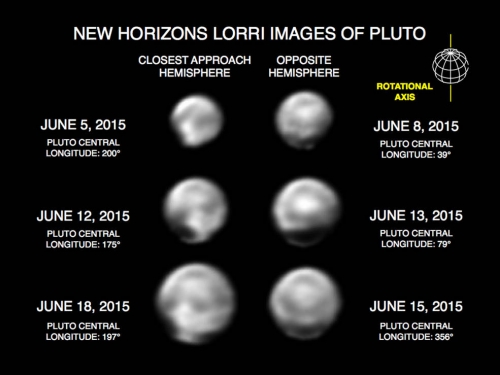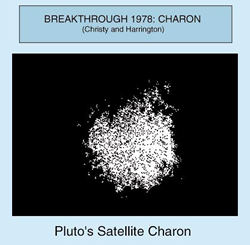An abrupt change: I’m holding today’s post (about halfway done, on a stellar flyby that may have produced Sedna and other such objects long in our system’s past) to turn to New Horizons’ latest imagery, which is provocative indeed. We’ll cover the Sedna story tomorrow.
What we have from New Horizons is the work of the spacecraft’s Long Range Reconnaissance Imager (LORRI) in a series of images that show Pluto and its largest moon Charon as they more than double in size between May 29 and June 19. There’s plenty here to marvel at, but what stands out for me is the mysterious dark region that NASA’s latest release refers to as ‘a kind of anti-polar cap’ on Charon. Have a look:

Image: These recent images show the discovery of significant surface details on Pluto’s largest moon, Charon. They were taken by the New Horizons Long Range Reconnaissance Imager (LORRI) on June 18, 2015. The image on the left is the original image, displayed at four times the native LORRI image size. After applying a technique that sharpens an image called deconvolution, details become visible on Charon, including a distinct dark pole. Deconvolution can occasionally introduce “false” details, so the finest details in these pictures will need to be confirmed by images taken from closer range in the next few weeks. Credit: NASA/Johns Hopkins University Applied Physics Laboratory/Southwest Research Institute.
No wonder principal investigator Alan Stern is beside himself:
“This system is just amazing. The science team is just ecstatic with what we see on Pluto’s close approach hemisphere: Every terrain type we see on the planet—including both the brightest and darkest surface areas — is represented there, it’s a wonderland! And about Charon—wow—I don’t think anyone expected Charon to reveal a mystery like dark terrains at its pole. Who ordered that?”
Moreover, we have these images of Pluto itself, with the encouraging news that the hemisphere over which New Horizons will make its closest approach is also the one with the greatest variety of terrain types we’ve yet seen on the dwarf planet. Here’s the Pluto imagery:

Image: These images, taken by New Horizons’ Long Range Reconnaissance Imager (LORRI), show numerous large-scale features on Pluto’s surface. When various large, dark and bright regions appear near limbs, they give Pluto a distinct, but false, non-spherical appearance. Pluto is known to be almost perfectly spherical from previous data. These images are displayed at four times the native LORRI image size, and have been processed using a method called deconvolution, which sharpens the original images to enhance features on Pluto. Credit: NASA/Johns Hopkins University Applied Physics Laboratory/Southwest Research Institute.

At left is Pluto/Charon as viewed in 1978 when USNO astronomer James Christy noticed the ‘bump’ that seemed to emerge from Pluto. This was how Charon was discovered, through imagery that, like Pluto itself in 1930, was studied on photographic plates taken in Flagstaff, AZ. Weighing only twelve percent as much as Pluto, Charon may be as much as half ice, while Pluto seems to be about 70 percent rock by mass. As this JHU//APL news release notes, an astronaut standing on Pluto’s surface would see Charon always in the same part of the sky, but it would appear seven times larger than the Earth’s moon, spanning 3.5 degrees. Now we have imagery like that above to bring both Pluto and Charon into ever tighter focus. Will we find ice volcanoes on Charon, and perhaps a trace of atmosphere?



so, what we know is that both Pluto and Charon and have same dark soft-edged features, so they *might* be related. Interesting days ahead
What is that image there above that is supposed to be the photograph from 1978 ? I don’t understand what it is were looking at their; they say something about a bump on Pluto? It looks like a aggregate of BBs or something-what is that we’re seeing there?
Charley, in the image from 1978, no one knew Pluto had a moon. The image they were working with was the best they had at the time — Charon looked like nothing more than a ‘bump’ on Pluto in that image, which led scientists to figure out that what they were actually seeing was a previously undiscovered moon.
For ALL the interplanetary missions that have been sent out – but have been had their management of the missions handled by others than JPL. Do all these institutions that manage these missions have their TRAJECTORY calculations performed in their behalf by the Ephemeris group at JPL ? Is this handled exclusively by that group ?
The other immediate question that I have on my mind relates the New Verizon mission to Pluto. I’d like to know if there have been any technical publications concerning the calculations behind the trajectory for that mission (this would be publications, either as papers or perhaps a collection of various papers) ? If so I would REALLY, REALLY be interested in getting the titles and the particular locations as to where these papers are published, so I may get a copy.
Paul, that version of the 1978 Charon discovery photograph (in reference to Charley’s comment) may not be a good reproduction (I’m not blaming you, of course). Back when Charon was found, the photograph I saw–in the “Weekly Reader” at my elementary school–showed a quite distinct “bump” on Pluto. Also:
I wonder if the dark pole might be dark pink nitrogen ice, as we saw on Triton’s illuminated pole? At this range, it might appear dark against a water ice/dirt background, much as Mars’ dark areas look quite dark in many Earth-based photographs, yet aren’t nearly so dark (in comparison to the red deserts surrounding them) when viewed from Mars orbit. It’s too bad New Horizons doesn’t have anything like IKAROS’s ejectable wireless cameras, so that the other side of Pluto could be imaged at equally-close range, but adding such a feature would have “busted” the project’s mass *and* financial budgets.
Charley:
What we are really seeing here is a conglomerate of silver grains that make up the photographic image of Pluto. Nothing but a dot, really, in close-up. The interesting feature that reveals Charon is the little deviation from circular that is seen at the upper right. Could be deemed non-significant noise in this image, but when you have multiple images and see it move around like clockwork, then you know you have a moon.
CharlesJQuarra:
There is really no telling from the blurry images whether they are soft or hard edged, nor whether they are in any way “same”. Furthermore, some of those “features” may yet turn out to be sharpening artifacts. Interesting days ahead, indeed!
An interview with the astronomer who discovered Charon with that “bumpy” image of Pluto back in 1978:
http://www.astronomy.com/year-of-pluto/2015/06/an-interview-with-jim-christy-how-defective-images-revealed-the-first-double-planet
How quickly things CHANGE! Click on http://www.portaltotheuniverse.org from here, then scroll down to The Planetary Society blog, and click THAT on! One NEW image has Charon’ s dark pole IN COLOR! ANOTHER has Charon in black and white, ritated 180 degrees. The dark pole is now BARELY VISABLE at the VERY TOP, BUT: Directly below is a dark BAND ( that probably does NOT COMPLETELY ENCIRCLE Charon) with a bright spot inside of it! MY only regret is , at closest approach, Charon will only be visable as a “half-moon”, and I do not know whether this new “dark band will be in the right place for u8p-close vie
How the Pluto Underground helped make New Horizons possible:
http://www.astronomy.com/year-of-pluto/2015/06/howd-we-get-new-horizons-you-can-thank-the-pluto-underground
Gregory Benford gives an overview of science fiction stories involving Pluto just before the NH probe arrives:
http://www.airspacemag.com/daily-planet/imagining-pluto-180955232/
NASA’s New Horizons Mission Update from the Johns Hopkins University Applied Physics Lab (APL)
Published on June 23, 2015
Weekly pre-flyby updates aired June 23 on NASA TV provides an overview of the New Horizons mission, the spacecraft and its suite of instruments being prepared for a July 14 flyby, and a summary of Pluto science to date.
https://www.youtube.com/watch?v=hGO1F6Qdwfk&app=desktop
“When the going gets wierd, the wierd turn pro” is a famous line from Hunter S Thompson’s famous book “Fear and loathing in Las Vegas.” Well folks, I JUST TURNED PRO! After clicking on http://www.slate/badastronomy.com, I saw an image of Pluto with TWO BRIGHT SPOTS in the same CONFIGURATION and same AREA as Ceres’ bright spots just after DAWN wa able th RESOLVE them. UFOlogists are going to have a field day with this one. AFTER VERY CAREFUL CONSIDERATION. my “PROFESSIONAL” opinion is that Pluto is OBVIOUSLY very very gealous of the attention Ceres is getting in what should be Pluto’ glory days. Seriously, I cant wait for the resolution of these spots to get better!